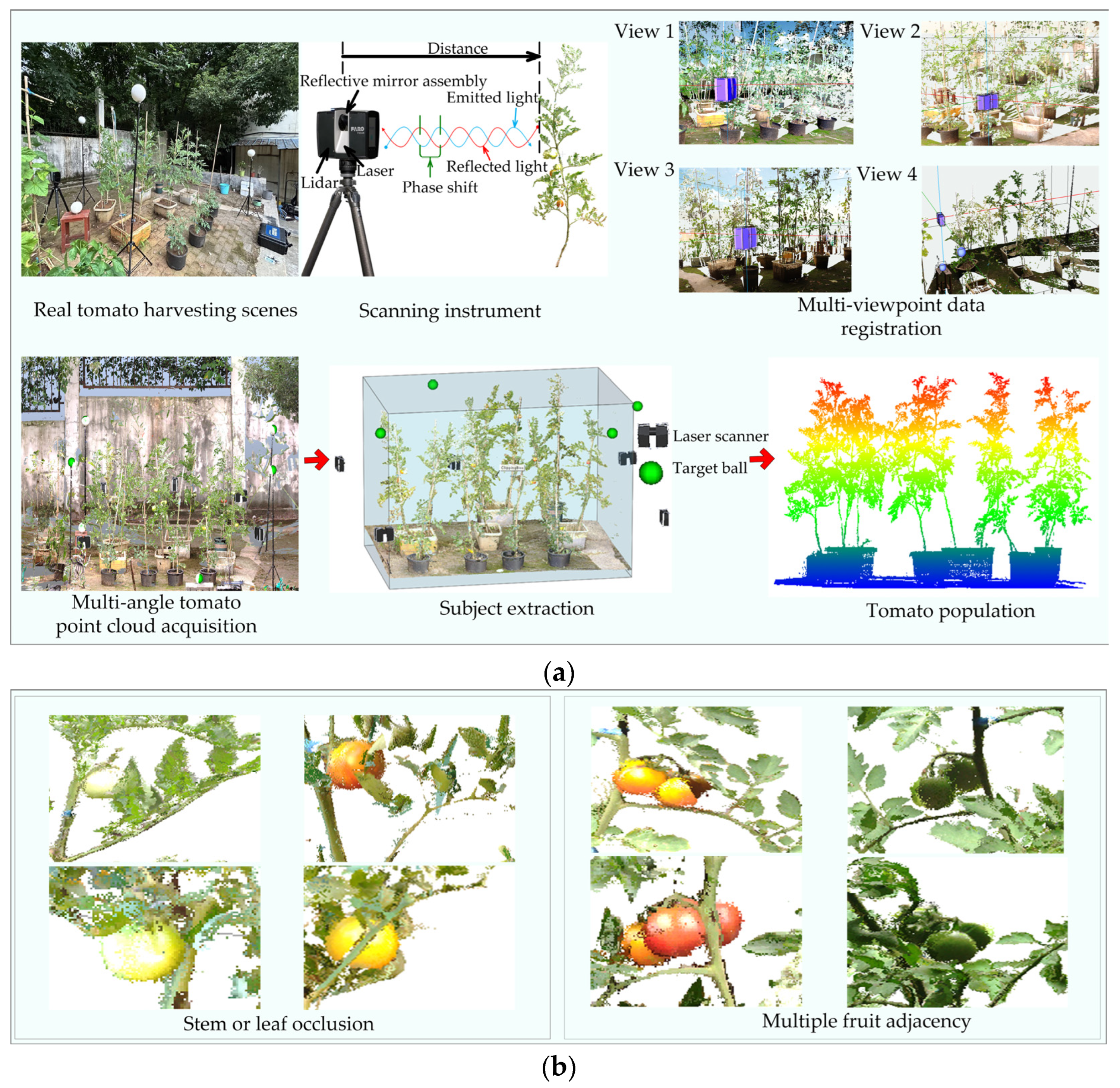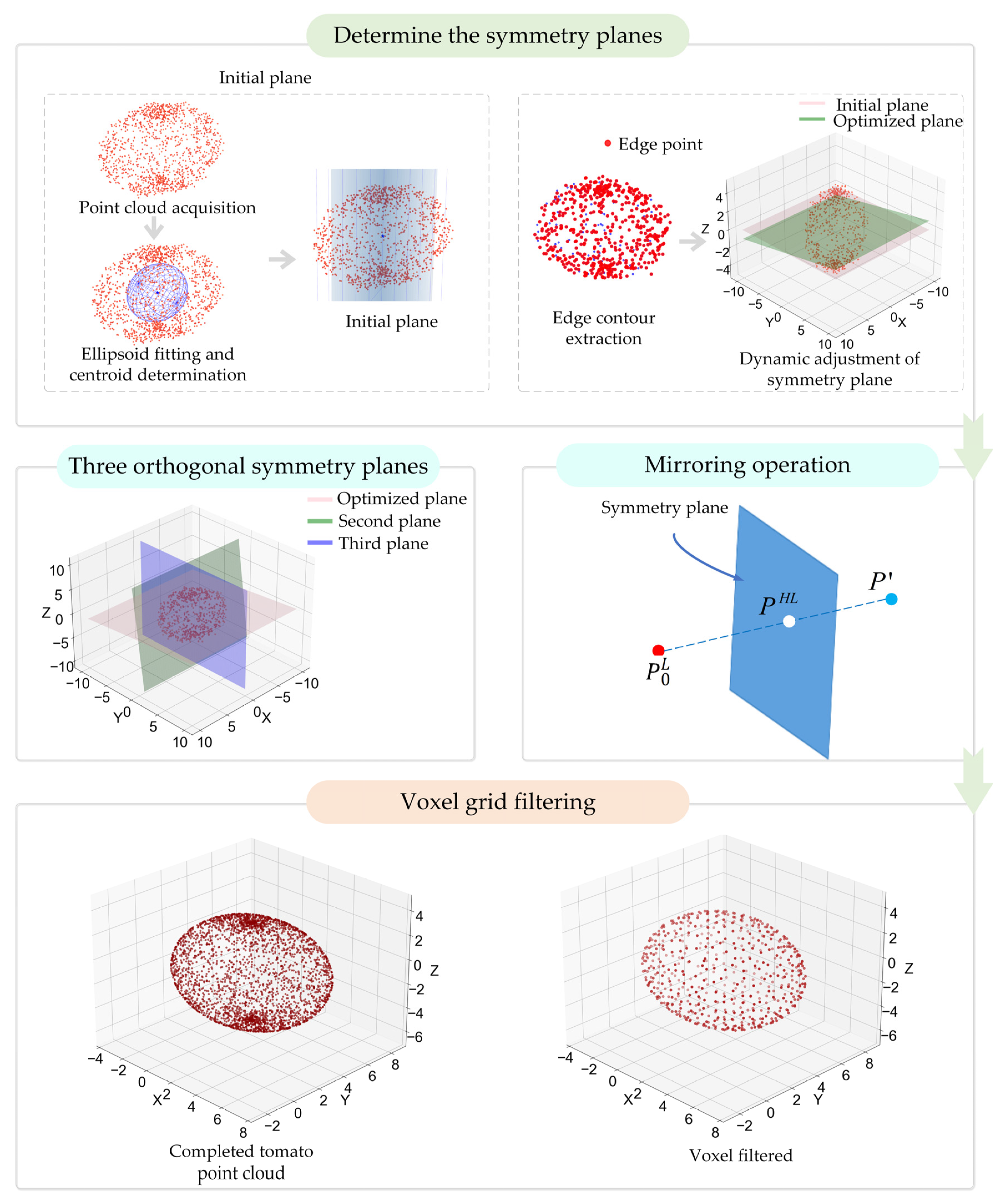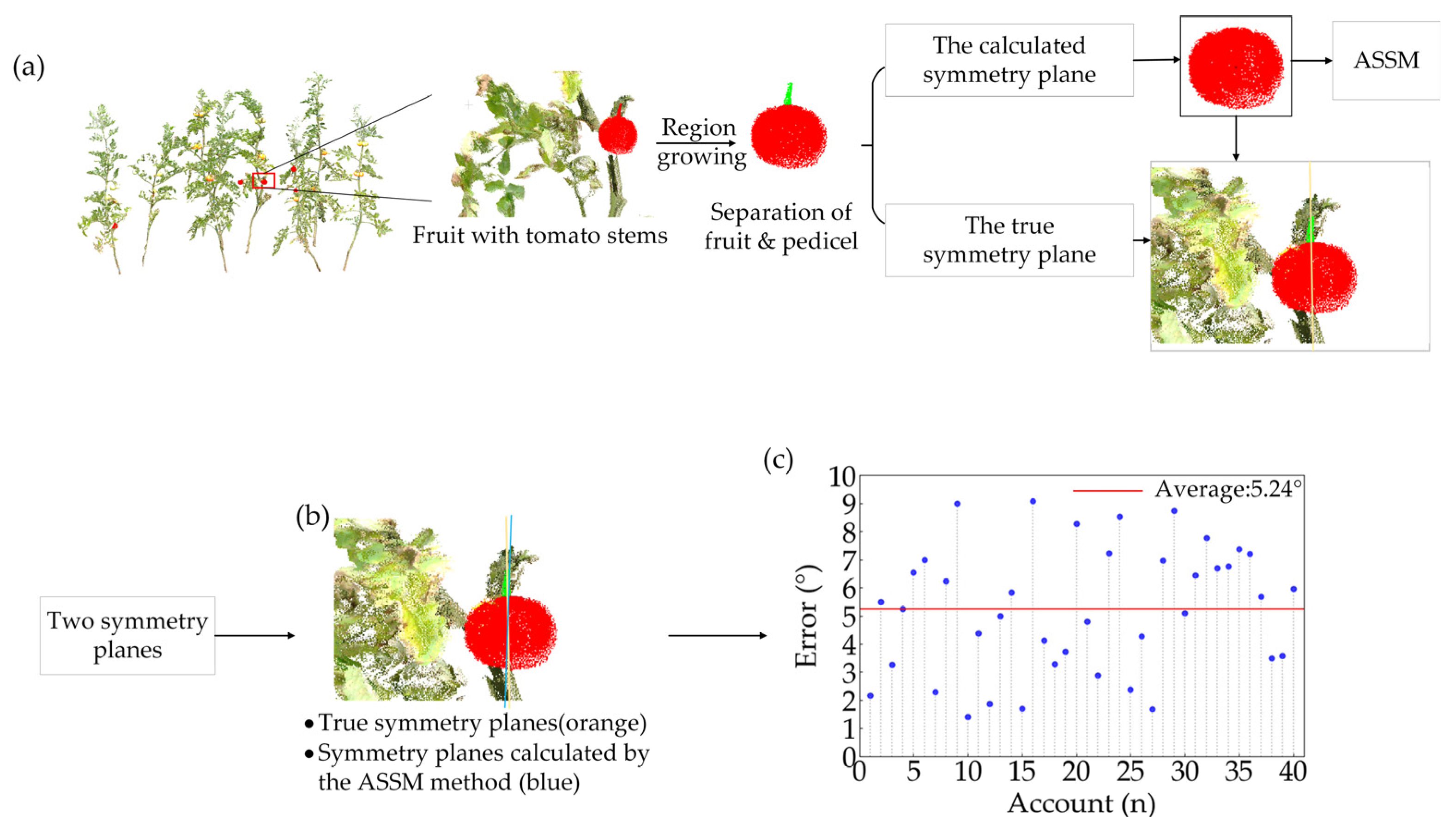Adaptive Symmetry Self-Matching for 3D Point Cloud Completion of Occluded Tomato Fruits in Complex Canopy Environments
Abstract
1. Introduction
2. Materials and Methods
2.1. Experimental Setup and Sample Acquisition
2.2. Fruit Occlusion Rate Calculation and Classification
2.3. Point Cloud Preprocessing
2.4. Tomato Fruit Extraction
2.5. Adaptive Symmetry–Dynamic Matching
2.5.1. Calculation of the Initial Symmetry
2.5.2. Adaptive Dynamic Matching Optimization
2.6. Triple-Orthogonal Symmetry Plane Synergy and Mirror Completion
2.6.1. Construction of Three Orthogonal Symmetry Planes
2.6.2. Point Cloud Mirroring and Final Integration
3. Results
3.1. Effectiveness of Tomato Fruit Extraction
3.2. Symmetry Plane Verification
3.3. Tomato Fruit Completion and Accuracy Analysis
4. Discussion
4.1. Accuracy of the Method of Determining the Plane of Symmetry
4.2. Comparison of Tomato Fruit Completion Methods
4.3. Validation of Cross-Crop Applicability Based on Fruit Completion Methods
4.4. Comparison with Deep Learning-Based Completion Methods
4.5. Limitations and Future Work
5. Conclusions
Author Contributions
Funding
Data Availability Statement
Conflicts of Interest
Abbreviations
| 3D | Three-Dimensional |
| ASSM | Adaptive Symmetry Self-Matching |
| ICP | Iterative Closest Point |
| K-D tree | K-Dimensional Tree |
| LiDAR | Light Detection and Ranging |
| PCA | Principal Component Analysis |
| RANSAC | Random Sample Consensus |
| R2 | Coefficient of Determination |
| RMSE | Root Mean Square Error |
| rRMSE | Relative Root Mean Square Error |
References
- van Dijk, M.; Morley, T.; Rau, M.L.; Saghai, Y. A meta-analysis of projected global food demand and population at risk of hunger for the period 2010–2050. Nat. Food 2021, 2, 494–501. [Google Scholar] [CrossRef] [PubMed]
- Maier, C.R.; Chen, Z.H.; Cazzonelli, C.I.; Tissue, D.T.; Ghannoum, O. Precise Phenotyping for Improved Crop Quality and Management in Protected Cropping: A Review. Crops 2022, 2, 336–350. [Google Scholar] [CrossRef]
- Fan, L.; Fang, S.; Fan, J.; Wang, Y.; Zhan, L.; He, Y. Rice Yield Estimation Using Machine Learning and Feature Selection in Hilly and Mountainous Chongqing, China. Agriculture 2024, 14, 1615. [Google Scholar] [CrossRef]
- Yang, W.; Feng, H.; Zhang, X.; Zhang, J.; Doonan, J.; Batchelor, W.; Xiong, L.; Yan, J. Crop phenomics and high-throughput phenotyping: Past decades, current challenges, and future perspectives. Mol. Plant 2020, 13, 187–214. [Google Scholar] [CrossRef]
- Li, N.; Wu, X.; Zhuang, W.; Xia, L.; Chen, Y.; Wu, C.; Rao, Z.; Du, L.; Zhao, R.; Yi, M. Tomato and lycopene and multiple health outcomes: Umbrella review. Food Chem. 2021, 343, 128396. [Google Scholar] [CrossRef] [PubMed]
- Natali, P.G.; Piantelli, M.; Sottini, A.; Eufemi, M.; Banfi, C.; Imberti, L. A step forward in enhancing the health-promoting properties of whole tomato as a functional food to lower the impact of non-communicable diseases. Front. Nutr. 2025, 12, 1519905. [Google Scholar] [CrossRef]
- He, B.; Wei, Y.; Wang, Y.; Zhong, Y.; Fan, M.; Gong, Q.; Lu, S.; Ul Hassan, M.; Li, X. Silicon application improves tomato yield and nutritional quality. BMC Plant Biol. 2025, 25, 252. [Google Scholar] [CrossRef]
- Li, T.; Feng, Q.; Qiu, Q.; Xie, F.; Zhao, C. Occluded apple fruit detection and localization with a frustum-based point-cloud-processing approach for robotic harvesting. Remote Sens. 2022, 14, 482. [Google Scholar] [CrossRef]
- Magistri, F.; Marks, E.; Nagulavancha, S.; Vizzo, I.; Läebe, T.; Behley, J.; Halstead, M.; McCool, C.; Stachniss, C. Contrastive 3D Shape Completion and Reconstruction for Agricultural Robots Using RGB-D Frames. IEEE Rob. Autom. Lett. 2022, 7, 10120–10127. [Google Scholar] [CrossRef]
- Jiang, Y.; Liu, Q.; Lu, W.; Zhou, B.; Smoleňová, K.; Tekinerdogan, B.; Yang, Q. Plant stem occlusion inpainting with Deep Reinforcement Learning. Comput. Electron. Agric. 2025, 237, 110465. [Google Scholar] [CrossRef]
- Magistri, F.; Pan, Y.; Bartels, J.; Behley, J.; Stachniss, C.; Lehnert, C. Improving Robotic Fruit Harvesting Within Cluttered Environments Through 3D Shape Completion. IEEE Robot. Autom. Lett. 2024, 9, 7357–7364. [Google Scholar] [CrossRef]
- Sari, Y.A.; Gofuku, A. Measuring food volume from RGB-Depth image with point cloud conversion method using geometrical approach and robust ellipsoid fitting algorithm. J. Food Eng. 2023, 238, 111656. [Google Scholar] [CrossRef]
- Sapkota, R.; Ahmed, D.; Churuvija, M.; Karkee, M. Immature Green Apple Detection and Sizing in Commercial Orchards Using YOLOv8 and Shape Fitting Techniques. IEEE Access 2024, 12, 43436–43452. [Google Scholar] [CrossRef]
- Verhoeven, V.B.; Raumonen, P.; Åkerblom, M. Fitting Geometric Shapes to Fuzzy Point Cloud Data. J. Imaging 2025, 11, 7. [Google Scholar] [CrossRef]
- Zhang, Z.; Dong, B.; Li, T.; Heide, F.; Peers, P.; Yin, B.; Yang, X. Single Depth-image 3D Reflection Symmetry and Shape Prediction. In Proceedings of the 2023 IEEE/CVF International Conference on Computer Vision (ICCV), Paris, France, 1–6 October 2023. [Google Scholar]
- Li, X.; Li, F.; Qi, Y.; Li, Z. Plantformer: Plant point cloud completion based on local–global feature aggregation and spatial context-aware transformer. Neural Comput. Appl. 2025, 37, 2747–2762. [Google Scholar] [CrossRef]
- Ge, Y.; Xiong, Y.; From, P.J. Symmetry-based 3D shape completion for fruit localisation for harvesting robots. Biosyst. Eng. 2020, 197, 18–202. [Google Scholar] [CrossRef]
- Huang, X.; Zheng, S.; Zhu, N. High-Throughput Legume Seed Phenotyping Using a Handheld 3D Laser Scanner. Remote Sens. 2022, 14, 431. [Google Scholar] [CrossRef]
- Wu, Z.L.; Jiang, H.Y.; He, S.Y. Symmetry Detection of Occluded Point Cloud Using Deep Learning. Procedia Comput. Sci. 2020, 183, 32–39. [Google Scholar] [CrossRef]
- Gao, R.; Zhou, Q.; Cao, S.; Jiang, Q. An algorithm for calculating apple picking direction based on 3d vision. Agriculture 2022, 12, 1170. [Google Scholar] [CrossRef]
- Yu, T.; Hu, C.; Xie, Y.; Liu, J.; Li, P. Mature pomegranate fruit detection and location combining improved f-pointnet with 3d point cloud clustering in orchard. Comput. Electron. Agric. 2022, 200, 107233. [Google Scholar] [CrossRef]
- Choi, H.; Park, J.; Park, S.H.; Lee, T. Nerf-based 3d reconstruction pipeline for acquisition and analysis of tomato crop morphology. Front. Plant Sci. 2024, 15, 1439086. [Google Scholar] [CrossRef] [PubMed]
- Chu, P.; Han, B.; Guo, Q.; Wan, Y.; Zhang, J. A Three-Dimensional Phenotype Extraction Method Based on Point Cloud Segmentation for All-Period Cotton Multiple Organs. Plants 2025, 14, 1578. [Google Scholar] [CrossRef]
- Ning, Y. Research on 3d point cloud registration method. Geomat. Spat. Inf. Technol. 2022, 45, 188–191. [Google Scholar]
- Lu, X.; Ono, E.; Lu, S.; Zhang, Y.; Teng, P.; Aono, M.; Shimizu, Y.; Hosoi, F.; Omasa, K. Reconstruction method and optimum range of camera-shooting angle for 3d plant modeling using a multi-camera photography system. Plant Methods 2020, 16, 18–191. [Google Scholar] [CrossRef] [PubMed]
- Wang, Y.; Hu, S.; Ren, H.; Yang, W.; Zhai, R. 3Dphenomvs: A low-cost 3d tomato phenotyping pipeline using 3d reconstruction point cloud based on multiview images. Agronomy 2022, 12, 1865. [Google Scholar] [CrossRef]
- Serdar, C.C.; Cihan, M.; Yücel, D.; Serdar, M.A. Sample size, power and effect size revisited: Simplified and practical approaches in pre-clinical, clinical and laboratory studies. Biochem. Medica 2021, 31, 010502. [Google Scholar] [CrossRef]
- Kang, H. Sample size determination and power analysis using the G*Power software. J. Educ. Eval. Health Prof. 2021, 18, 17. [Google Scholar] [CrossRef]
- Chen, H.; Liu, S.; Wang, C.; Wang, C.; Gong, K.; Li, Y.; Lan, Y. Point Cloud Completion of Plant Leaves under Occlusion Conditions Based on Deep Learning. Plant Phenomics 2023, 5, 0117. [Google Scholar] [CrossRef]
- Rivera, G.; Porras, R.; Florencia, R.; Sánchez-Solís, J.P. Lidar applications in precision agriculture for cultivating crops: A review of recent advances. Comput. Electron. Agric. 2023, 207, 107737. [Google Scholar] [CrossRef]
- Teh, H.; Kempa-Liehr, A.; Wang, K. Sensor data quality: A systematic review. J. Big Data 2020, 7, 11. [Google Scholar] [CrossRef]
- Zhang, R.; Zhang, Z.; Zhang, W.; He, L.; Zhu, C. Deep learning-driven semantic segmentation and spatial analysis of quarry relic landscapes using point cloud data: Insights from the Shaoxing quarry relics. npj Herit. Sci. 2025, 13, 77. [Google Scholar] [CrossRef]
- Xie, T.; Zhu, J.; Wang, C.; Li, F.; Meng, Z. A Unified Denoising Framework for Restoring the LiDAR Point Cloud Geometry of Reflective Targets. Appl. Sci. 2025, 15, 3904. [Google Scholar] [CrossRef]
- Yang, S.; Gao, W.; Mi, J.; Wu, M.; Wang, M.; Zheng, L. Method for measurement of vegetable seedlings height based on rgb-d camera. Trans. Chin. Soc. Agric. Mach. 2019, 50, 128–135. [Google Scholar]
- Zhang, C.; Zhang, K.; Ge, L.; Zou, K.; Wang, S.; Zhang, J.; Li, W. A method for organs classification and fruit counting on pomegranate trees based on multi-features fusion and support vector machine by 3d point cloud. Sci. Hortic. 2021, 278, 109791. [Google Scholar] [CrossRef]
- Li, G.; Liang, Z.; Shi, X.; Sun, W. Research on laser point cloud reduction method based on curvature feature constraint. Comput. Digit. Eng. 2020, 48, 2034–2037+2063. [Google Scholar]
- Adhikari, P.; McNellie, J.; Panthee, D.R. Detection of Quantitative Trait Loci (QTL) Associated with the Fruit Morphology of Tomato. Genes 2020, 11, 1117. [Google Scholar] [CrossRef]
- Bálint, A.; Teschner, G.; Kovács, A.J.; Neményi, M.; Helyes, L.; Pékk, Z.; Takács, S.; Alahmad, T.; Nyéki, A. Field-grown tomato yield estimation using point cloud segmentation with 3D shaping and RGB pictures from a field robot and digital single lens reflex cameras. Heliyon 2024, 10, e37997. [Google Scholar]
- Vazquez, D.V.; Spetale, F.E.; Nankar, A.N.; Grozeva, S.; Rodríguez, G.R. Machine Learning-Based Tomato Fruit Shape Classification System. Plants 2024, 13, 2357. [Google Scholar] [CrossRef]
- Alexiou, E.; Zhou, X.; Viola, I.; Cesar, P. PointPCA: Point cloud objective quality assessment using PCA-based descriptors. EURASIP J. Image Video Process. 2024, 2024, 20. [Google Scholar] [CrossRef]
- Liu, X.; Wang, R.; Wang, Z. Research on a Point Cloud Registration Method Based on Dynamic Neighborhood Features. Appl. Sci. 2025, 15, 4036. [Google Scholar] [CrossRef]
- Ma, B.; Xia, H.; Ge, Y.; Zhang, H.; Wu, Z.; Li, M.; Wang, D. A Method for Identifying Picking Points in Safflower Point Clouds Based on an Improved PointNet++ Network. Agronomy 2025, 15, 1125. [Google Scholar] [CrossRef]
- Jiang, L.; Wang, Y.; Yan, H.; Yin, Y.; Wu, C. Strawberry Fruit Deformity Detection and Symmetry Quantification Using Deep Learning and Geometric Feature Analysis. Horticulturae 2025, 11, 652. [Google Scholar] [CrossRef]
- Pinkham, R.; Zeng, S.; Zhang, Z. Quicknn: Memory and performance optimization of k-d tree based nearest neighbor search for 3D point clouds. In Proceedings of the 2020 IEEE International Symposium on High Performance Computer Architecture (HPCA), San Diego, CA, USA, 22–26 February 2020. [Google Scholar]
- James, C.; Chandra, S.S.; Chapman, C. A scalable and efficient UAV-based pipeline and deep learning framework for phenotyping sorghum panicle morphology from point clouds. Plant Phenomics 2025, 7, 100050. [Google Scholar] [CrossRef]
- Ni, J.; Zhu, L.; Dong, L.; Wang, R.; Chen, K.; Gao, J.; Wang, W.; Zhou, L.; Zhao, B.; Rong, J.; et al. TomatoPoseNet: An Efficient Keypoint-Based 6D Pose Estimation Model for Non-Destructive Tomato Harvesting. Agronomy 2024, 14, 3027. [Google Scholar] [CrossRef]
- Peng, C.; Feng, Q.; Guo, Z.; Ma, Y.; Li, Y.; Zhang, Y.; Gao, L. Structural Parameter Optimization of a Tomato Robotic Harvesting Arm: Considering Collision-Free Operation Requirements. Plants 2024, 13, 3211. [Google Scholar] [CrossRef]









| Category | Implementation Standard |
|---|---|
| Measurement range | 0.6 m–70 m |
| Ranging error | ±1 mm |
| Scanning speed | ≤9.760 × 105 dots/s |
| Scanning field of view | Horizontal 360° × vertical 300° |
| Operating temperature | 20 ± 5 °C |
| Color scan | Average weighted metering |
| Scan Date | Fruit Numbers | LiDAR Numbers | Plant Numbers |
|---|---|---|---|
| 24 June 2024 | 10 | 5 | 8 |
| 15 July 2024 | 8 | 6 | 8 |
| 22 July 2024 | 8 | 5 | 10 |
| 28 July 2024 | 8 | 5 | 8 |
| 6 August 2024 | 8 | 4 | 8 |
| Obstruction Level | Obstruction Ratio (%) | Fruit | Typical Occlusion Scenarios |
|---|---|---|---|
| Low | ≤30 | 30 | Partial leaf occlusion |
| Middle | <30–≤50 | 80 | Top and side composite occlusion |
| High | <50–≤70 | 40 | Dense multi-source occlusion |
| Obstruction Level | Method | Dimensional Data | R2 | RMSE (mm) | rRMSE | p * |
|---|---|---|---|---|---|---|
| Low | ASSM | Fruit length | 0.9488 | 2.4000 | 0.0453 | <0.001 *** |
| Fruit width | 0.9823 | 1.4810 | 0.0287 | <0.001 *** | ||
| Fruit height | 0.9151 | 4.4514 | 0.0984 | <0.001 *** | ||
| Ellipsoid fitting | Fruit length | 0.9124 | 2.8437 | 0.0536 | 0.009 * | |
| Fruit width | 0.7784 | 5.7473 | 0.1114 | 0.047 * | ||
| Fruit height | 0.8895 | 4.5644 | 0.1009 | <0.001 *** | ||
| Middle | ASSM | Fruit length | 0.9933 | 1.1098 | 0.0199 | 0.1347 |
| Fruit width | 0.9665 | 2.9495 | 0.0563 | <0.001 *** | ||
| Fruit height | 0.9818 | 2.8425 | 0.0574 | <0.001 *** | ||
| Ellipsoid fitting | Fruit length | 0.9816 | 1.8127 | 0.0326 | 0.3599 | |
| Fruit width | 0.9284 | 4.0436 | 0.0771 | <0.001 *** | ||
| Fruit height | 0.8594 | 6.5552 | 0.1324 | <0.001 *** | ||
| High | ASSM | Fruit length | 0.9914 | 1.6261 | 0.0341 | <0.001 *** |
| Fruit width | 0.9880 | 1.6442 | 0.0359 | <0.001 *** | ||
| Fruit height | 0.9349 | 4.3583 | 0.1043 | <0.001 *** | ||
| Ellipsoid fitting | Fruit length | 0.9805 | 2.1259 | 0.0446 | 0.009 * | |
| Fruit width | 0.9101 | 4.3542 | 0.0951 | 0.047 * | ||
| Fruit height | 0.8489 | 5.5613 | 0.1331 | <0.001 *** |
| Method | Dimensional Data | R2 | RMSE (mm) | rRMSE |
|---|---|---|---|---|
| ASSM | Fruit length | 0.9896 | 2.9072 | 0.0401 |
| Fruit width | 0.9776 | 3.8759 | 0.0568 | |
| Fruit height | 0.9752 | 3.8095 | 0.0609 | |
| Ellipsoid fitting | Fruit length | 0.9751 | 4.0022 | 0.0552 |
| Fruit width | 0.9591 | 4.8265 | 0.0708 | |
| Fruit height | 0.9355 | 5.5238 | 0.0884 |
Disclaimer/Publisher’s Note: The statements, opinions and data contained in all publications are solely those of the individual author(s) and contributor(s) and not of MDPI and/or the editor(s). MDPI and/or the editor(s) disclaim responsibility for any injury to people or property resulting from any ideas, methods, instructions or products referred to in the content. |
© 2025 by the authors. Licensee MDPI, Basel, Switzerland. This article is an open access article distributed under the terms and conditions of the Creative Commons Attribution (CC BY) license (https://creativecommons.org/licenses/by/4.0/).
Share and Cite
Wang, W.; Lin, C.; Shui, H.; Zhang, K.; Zhai, R. Adaptive Symmetry Self-Matching for 3D Point Cloud Completion of Occluded Tomato Fruits in Complex Canopy Environments. Plants 2025, 14, 2080. https://doi.org/10.3390/plants14132080
Wang W, Lin C, Shui H, Zhang K, Zhai R. Adaptive Symmetry Self-Matching for 3D Point Cloud Completion of Occluded Tomato Fruits in Complex Canopy Environments. Plants. 2025; 14(13):2080. https://doi.org/10.3390/plants14132080
Chicago/Turabian StyleWang, Wenqin, Chengda Lin, Haiyu Shui, Ke Zhang, and Ruifang Zhai. 2025. "Adaptive Symmetry Self-Matching for 3D Point Cloud Completion of Occluded Tomato Fruits in Complex Canopy Environments" Plants 14, no. 13: 2080. https://doi.org/10.3390/plants14132080
APA StyleWang, W., Lin, C., Shui, H., Zhang, K., & Zhai, R. (2025). Adaptive Symmetry Self-Matching for 3D Point Cloud Completion of Occluded Tomato Fruits in Complex Canopy Environments. Plants, 14(13), 2080. https://doi.org/10.3390/plants14132080





